
Ericsson is back to job cutting once again. Confirming an earlier report by Reuters, which cited an internal memo as its source, the Swedish equipment maker says about 8,500 roles will be axed, a figure equal to about 8% of the current company total. Most of the affected staff will be gone by the summer, Ericsson believes, but the multinational effort could extend into next year.
Ericsson's last big round of layoffs came after Börje Ekholm joined the company as CEO in early 2017. That year, the operator cut a net total of 10,729 jobs, according to its annual reports, before dispensing with another 5,376 in 2018. A decision to quit various non-core activities and focus on restoring profitability at its main networks unit was held largely responsible. Since then, the company has gained 10,170 employees, giving it 105,529 at the end of last year, through takeover activity and expansion. The recent $6 billion move for Vonage brought with it a couple of thousand workers.
Figure 2: Ericsson number of employees 2015 to 2023  Headcount at Ericsson has fluctuated over the past several years but generally has fallen.
Headcount at Ericsson has fluctuated over the past several years but generally has fallen.
(source: Ericsson)
"We see potential to simplify and become more efficient across the company, especially in structural costs. But we are also working on our service delivery, supply, real estate and IT," said Ericsson in a statement emailed to Light Reading. "It will, however, unfortunately result in a need to address headcount. We believe a total of 8,500 positions will be affected."
The news is not entirely a surprise, even if the cuts go deeper than many would have expected. It follows an earlier Reuters report saying Ericsson planned to cut 1,400 jobs in Sweden and possibly thousands elsewhere. Ericsson, moreover, had already told investors at its recent Capital Markets Day of plans to reduce annual run-rate costs by 9 billion Swedish kronor (USD$860 million) before the end of 2023. It hopes to find 70% of the savings within cost of goods sold and another 30% in selling, general and administrative expenses.
Gloomier days
Ericsson has also recently lumped together two formerly separate units – digital and managed services – to create a unified cloud software and services division. Such moves normally result in headcount reduction, and Ericsson has talked up the opportunity to use more automation in this part of its business.
Takeover activity has probably left Ericsson with surplus staff, too, and especially the acquisition of Vonage. Not all the platform company's various activities hold equal interest for Ericsson (judging by its previous commentary). And there would undoubtedly be some overlap in central services functions between Vonage and the team Ericsson already had.
On top of all that, these are gloomier days for a company that generates 70% of its revenues by selling mobile network equipment. The addressable market appears to have grown in the last couple of years thanks to the rollout of new 5G networks, but Ericsson – using forecasts by market-research firm Dell'Oro Group – does not expect the overall market for radio access network (RAN) products to get any bigger for several years.
To grow its own revenues, then, the company needs to capture market share from rivals, something it has done well for a few years running. Indeed, executives claim Ericsson's share of the RAN sector has risen from about 33% in 2017 to 39% at the end of last year. But the market looks more crowded these days, with Asian companies like Fujitsu, NEC and Samsung pushing competitive 5G products. Nordic rival Nokia also looks in better mobile shape than it has for ages.
Ericsson's profitability is already under pressure. Despite growing sales by 17% last year, to about SEK271.5 billion ($26 billion), Ericsson saw a 15% drop in operating income, to SEK27 billion ($2.6 billion). In his published remarks for the last earnings report, Ekholm blamed the "inflationary environment" and drew attention to cost-saving targets. Expenses have risen as energy prices have soared. What has been described as a "cost-of-living crisis" in the mainstream press has triggered workforce demands for higher pay.
Ericsson is still in much better shape than it was when Ekholm arrived. Back then, the company had just reported a SEK1.6 billion ($150 million) loss for the final quarter of 2016 and an operating margin of only 2.8% for the full year. It was 10% last year, but down 3.7 percentage points on the figure for 2021. Ekholm knows that without hefty pruning that measure could be in jeopardy.
Related posts:
— Iain Morris, International Editor, Light Reading
About the Author(s)
You May Also Like











